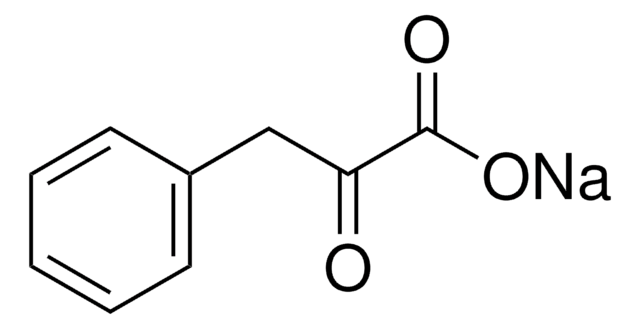286958
Phenylpyruvic acid
98%
Sinónimos:
2-Oxo-3-phenylpropanoic acid, 2-Oxo-3-phenylpropionic acid
Iniciar sesiónpara Ver la Fijación de precios por contrato y de la organización
About This Item
Fórmula lineal:
C6H5CH2COCOOH
Número de CAS:
Peso molecular:
164.16
Beilstein:
2207312
Número CE:
Número MDL:
Código UNSPSC:
12352100
ID de la sustancia en PubChem:
NACRES:
NA.22
Productos recomendados
Ensayo
98%
mp
150-154 °C (lit.)
grupo funcional
carboxylic acid
ketone
phenyl
temp. de almacenamiento
−20°C
cadena SMILES
OC(=O)C(=O)Cc1ccccc1
InChI
1S/C9H8O3/c10-8(9(11)12)6-7-4-2-1-3-5-7/h1-5H,6H2,(H,11,12)
Clave InChI
BTNMPGBKDVTSJY-UHFFFAOYSA-N
¿Está buscando productos similares? Visita Guía de comparación de productos
Descripción general
Phenylpyruvic acid reduces glucose-6-phosphate dehydrogenase activity without pre-incubation.
Aplicación
Phenylpyruvic acid was used in the synthesis of 3-phenyllactic acid (PLA) by lactate dehydrogenase.
Código de clase de almacenamiento
11 - Combustible Solids
Clase de riesgo para el agua (WGK)
WGK 3
Punto de inflamabilidad (°F)
Not applicable
Punto de inflamabilidad (°C)
Not applicable
Equipo de protección personal
Eyeshields, Gloves, type N95 (US)
Elija entre una de las versiones más recientes:
¿Ya tiene este producto?
Encuentre la documentación para los productos que ha comprado recientemente en la Biblioteca de documentos.
Los clientes también vieron
Shuhuai Yu et al.
Biotechnology letters, 36(3), 627-631 (2013-11-20)
3-Phenyllactic acid (PLA) is an antimicrobial compound with broad and effective antimicrobial activity against both bacteria and fungi. Enzymatic production of PLA can be carried out from phenylpyruvic acid by lactate dehydrogenase (LDH); however, the enzymatic reaction is accompanied by
Paddy Jim Baggot et al.
Fetal diagnosis and therapy, 23(3), 245-248 (2008-04-18)
Organic acids were examined from normal and Down syndrome pregnancies to identify possible differences between the amniotic fluid from fetuses with Down Syndrome compared with that of normal fetuses. Amniotic fluids were obtained from prior amniocenteses. Forty-one normal and 22
Zhaojuan Zheng et al.
PloS one, 6(4), e19030-e19030 (2011-05-03)
Phenyllactic acid (PLA), a novel antimicrobial compound with broad and effective antimicrobial activity against both bacteria and fungi, can be produced by many microorganisms, especially lactic acid bacteria. However, the concentration and productivity of PLA have been low in previous
Valeriano Dal Cin et al.
The Plant cell, 23(7), 2738-2753 (2011-07-14)
Altering expression of transcription factors can be an effective means to coordinately modulate entire metabolic pathways in plants. It can also provide useful information concerning the identities of genes that constitute metabolic networks. Here, we used ectopic expression of a
Joo Won Park et al.
Experimental & molecular medicine, 42(2), 105-115 (2009-12-01)
Phenylketonuria is an autosomal recessive disorder caused by a deficiency of phenylalanine hydroxylase. Transthyretin has been implicated as an indicator of nutritional status in phenylketonuria patients. In this study, we report that phenylalanine and its metabolite, phenylpyruvic acid, affect MAPK
Nuestro equipo de científicos tiene experiencia en todas las áreas de investigación: Ciencias de la vida, Ciencia de los materiales, Síntesis química, Cromatografía, Analítica y muchas otras.
Póngase en contacto con el Servicio técnico











